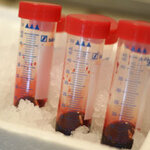Technology

Researchers have created a noninvasive way to detect heart-transplant rejection weeks or months earlier than previously possible. The test relies on the detection of increasing amounts of the donor's DNA in the blood of the recipient and does not require the removal of any heart tissue.
The test, called a cell-free DNA test, is different from another blood test, AlloMap, used to detect rejection. The commercially available AlloMap uses a blood sample to analyze the expression of immune-system genes involved in rejection. The researchers found that the cell-free DNA test outperformed AlloMap…

A paper presented at the ACM SIGMETRICS conference today revealed a crucial security problem in Google Play, the official Android app store where millions of users of Android, the most popular mobile platform, get their apps.
Jason Nieh, professor of computer science at Columbia Engineering, and PhD candidate Nicolas Viennot conducted a large-scale measurement of the huge Google Play marketplace by developing PlayDrone, a tool that uses various hacking techniques to circumvent Google security to successfully download Google Play apps and recover their sources.
PlayDrone, they said,…

The process of blood glucose control could improve dramatically with a bionic pancreas, according to a new study. Currently, people with type 1 diabetes maintain a constant vigil because their pancreas doesn't make the hormone insulin and so they need to manually insure that blood glucose levels don't get dangerously high and low. Several times a day they must use fingerstick tests to monitor their blood glucose levels and manually take insulin by injection or from a pump.
People who used a bionic pancreas instead of a pump were more likely to have blood glucose levels consistently…

Most people feel comfortable conducting financial transactions on the Web, the cryptographic schemes that protect online banking and credit card purchases have proven their reliability over decades.
But while outside hacking efforts get a lot of media attention, real security problems are more likely to occur inside the sites you trust. Every month seems to bring another story of private information accidentally leaked by governmental agencies or vendors.
Tighter restrictions on access could undermine the whole point of sharing data and that will be a detriment in something like health…

The first cases of Mad Cow disease in humans - properly known as variant Creutzfeld Jakob Disease, or vCJD, though no one recognizes that name - occurred in the late 1990s and were thought to be the consequence of eating contaminated beef products.
Since then, several cases of secondary infections caused by transfusions with blood from donors who subsequently developed vCJD have been reported, raising concerns about the safety of blood and blood products. A new paper describes an assay that can detect prions in blood samples from humans with vCJD and in animals at early stages of the (…

Phone dating apps used by gay men to find a sexual partner lead to a higher risk of getting common sexually transmitted infections than meeting online or in bars and clubs, suggests a new paper in Sexually Transmitted Infections.
Previous research has suggested that gay and bi-curious men who meet online are more likely to indulge in unprotected sex and to have more partners than men meeting potential partners in other ways. Smartphone apps such as Grindr, Scruff, and Recon have become an increasingly popular way to hook up with potential sexual partners. They allow registered users to use…

As I write this impromptu post the 2nd day of a search technology conference in Seattle is closing with the usual after-hours partying. People are happily writing blog posts and newsletters that digest the things they have learned from the conference and they will continue the process that has led to your reading my post here on Science 2.0.That process can be boiled down to "figure out something to say online and then figure out how to get people to read it". I'll do my part by Tweeting and SHARING this post after it has been published but that is "old school" marketing. It…

Every day thousands of people around the world have their lives saved or improved thanks to someone giving blood but it has limitations. It's shelf life can be limited, blood types need to match and the public needs to be willing to do it. That's without the safety concerns of donated blood. All of these things add to the cost.
The system works - over 85 million units of donated blood are given to people worldwide for use in hospitals - but there are worries about its use in routine operations, and the number of potential and active blood donors decreasing worldwide.
In the future…
Imagine a world where the tedious moments of life, cleaning or driving a car or whatever, could be spent visiting the Louvre or meeting new people or learning history.
The whole universe of information is at your fingertips. The only evidence of intelligence is how well you utilize the system, multitasking and parsing information while chatting and even letting someone ride shotgun in your experiences. Genius itself would be redefined.
Then imagine it all disappeared. Could you remember what people told you without a digital archive of the conversation? How they look? Could you find…

If you ask any journalist who writes a science article, or a PR person pitching one, if they would rather have a blurb about their work or get mentioned on Twitter, every single one will go for the link from Science 2.0.
Social media is all the rage, and it is great for mobilizing protests against stupid yogurt companies, but for research it is a lost cause compared to getting a link from a popular website. It's not just investigators, even health policy researchers, who need to be in tune with the public, know this. While 20 percent use Facebook or blog, only 14 percent. Most stick with…